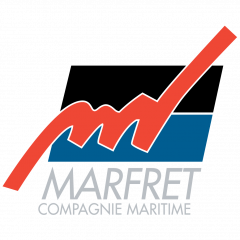The Marseille Fret Company was founded in Marseille in the early 1950s. Several intense and eventful decades have made Marseille-Fret –Marfret from 1987 onwards- into a singular shipping company present in 30 countries around the world.
1950-1960 : COASTAL SHIPPING IN THE MEDITERRANEAN
It was in 1951 that Claude Vidil and Pierre Giraud had the idea to set up their own shipping company - Marseille-Fret, starting with the charter of an Icelandic fishing schooner, the "Douce France".
The ship operated between Marseille, Algeria and Tunisia, returning via Corsica, loaded with cargoes ranging from tiles and cement to gas bottles and cork. Very soon, the two entrepreneurs were able to purchase their first vessels:
- le “Côte des Légendes” in 1955
- le “Ville de Saint-Pierre” in 1956
- le “Douce France II” in 1960

Claude Vidil
1960-1980 : DEVELOPMENT OF EASTERN MEDITERRANEAN SERVICES
The early sixties were a time of decolonization, with a knock-on effect in the shipping world that saw the advent of state-owned North African fleets. Bi-lateral conferences were set up that divided up foreign trade among the French and North African fleets, using a system that didn't favour young entrepreneurs generally -and Marseille-Fret in particular- based on historical load data.
This made it a very difficult time. In a bid to find new horizons, the two executives started a service to Libya and expanded their sales network, opening offices in Paris, Rouen and Dunkirk. This growth led to an increase in the fleet size, with the addition of the "Saumaty" and "Tamaris" in 1973, the "Rove" in 1975 and the "Méjean III" in 1977.
This period came to a close with a landmark event in the company's history: in October 1979, the Libyan government seized the company's flagship vessel the "Rove" while docked in Benghazi. For Marseille-Fret, the future of its Mediterranean operations was looking bleak.
This made it a very difficult time. In a bid to find new horizons, the two executives started a service to Libya and expanded their sales network, opening offices in Paris, Rouen and Dunkirk. This growth led to an increase in the fleet size, with the addition of the "Saumaty" and "Tamaris" in 1973, the "Rove" in 1975 and the "Méjean III" in 1977.
This period came to a close with a landmark event in the company's history: in October 1979, the Libyan government seized the company's flagship vessel the "Rove" while docked in Benghazi. For Marseille-Fret, the future of its Mediterranean operations was looking bleak.
1980-1995 : A CHANGE OF STRATEGY: SCHEDULED SERVICES OUTSIDE THE MEDITERRANEAN
At the beginning of the 1980s, Marseille-Fret began operating regular lines. At the request of the Rouen port authorities, the company opened a container service between Rouen and the West Indies. After difficult beginnings, the line's profitability increased and others were added, including a line to Canada in 1984.
In 1987, the activities were separated:
In 1987, the activities were separated:
Marseille-Fret
Becomes a holding company, while retaining the fleet and manning services.
Marfret
Is created to manage line operations.
Marfret continued to expand its service offer, with a service from the Mediterranean to Venezuela, Colombia and the Caribbean being introduced in 1987.
1995-2000 : MARFRET BECOMES A SMALL GLOBAL CARRIER
The mid-1990s saw the start of a prosperous time for the company with the decision to create alliances with its competitors (CMA CGM, Sudcargos, Maersk, Contship etc.). The aim of this was to offer joint services that would provide several benefits, including economies of scale thanks to the use of bigger ships and an increase in schedule frequency.
While new scheduled services were opening one after the other, Marfret was also consolidating its established lines: Marseille / Algeria - Tunisia, North Europe / French Guiana-Northern Brazil, North Europe / Canada, North Europe / French West Indies, Round-the-World, North Europe / Colombia, Mediterranean / Caribbean, Ireland (Le Havre / Waterford).
Today, Marfret is present on every continent thanks to a network of agents in 35 countries and five overseas departments and territories. In 1996, the company acquired a new ship, the "Providence".
While new scheduled services were opening one after the other, Marfret was also consolidating its established lines: Marseille / Algeria - Tunisia, North Europe / French Guiana-Northern Brazil, North Europe / Canada, North Europe / French West Indies, Round-the-World, North Europe / Colombia, Mediterranean / Caribbean, Ireland (Le Havre / Waterford).
Today, Marfret is present on every continent thanks to a network of agents in 35 countries and five overseas departments and territories. In 1996, the company acquired a new ship, the "Providence".
SINCE 2000
2000-2005 : BACK TO THE COASTAL TRADE
After having set up several scheduled east-west services, Marfret revisited its past with several north-south short-sea routes including:
- Pointe à Pitre / Fort de France thanks to its service “Ferrymar”
- Antilles / Guyane via Trinidad as an extension to its Europe du Nord / Guyane-Nord Brésil
- Barge service between Rouen et Le Havre
SINCE 2005
In 2005, the market saw an increase in consolidation, with the emergence of "super shipping lines" who now dominate the business. Some of these mergers and acquisitions had a direct impact on the alliances in which Marfret was a partner and new arrangements had to be found.
Marfret has continued to consolidate its presence in France and overseas, opening branch offices in Le Havre (2003), French Guiana (2005), Paris, the United States and Algeria (2006).
In 2005, Marfret created FluvioFeeder and is now one of the leading river and multimodal container freight operators on the river Seine.
In 2008, the Group completed its €185M five-year plan to renew its fleet and now owns five vessels, four container ships and one ro-ro.
In a booming sector dominated by the globalization of trade and increasing consolidation, Marfret's independence and responsiveness ensures both freedom of choice and a high quality of service for its clients.
Marfret has continued to consolidate its presence in France and overseas, opening branch offices in Le Havre (2003), French Guiana (2005), Paris, the United States and Algeria (2006).
In 2005, Marfret created FluvioFeeder and is now one of the leading river and multimodal container freight operators on the river Seine.
In 2008, the Group completed its €185M five-year plan to renew its fleet and now owns five vessels, four container ships and one ro-ro.
In a booming sector dominated by the globalization of trade and increasing consolidation, Marfret's independence and responsiveness ensures both freedom of choice and a high quality of service for its clients.
